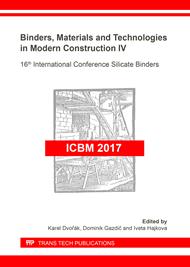p.83
p.89
p.97
p.103
p.110
p.116
p.122
p.128
p.134
The Suitability of Fly Ash for Use in Concrete According to EN 450 Based on their Particle Size
Abstract:
The by-products of energy industry are nowadays often affected by new limits governing the production of harmful gases discharged into the air. These stricter and stricter criteria are often met by electricity producers by changing the combustion process in thermal power plants itself. Nowadays, the SNCR (selective non-catalytic reduction) application is quite common in the combustion process in order to help reduce the nitrogen oxide emission. This article deals with the primary measures of thermal power plants, which in particular consist of a modified treatment of raw materials (coal) entering the combustion process. These primary measures then often cause the formation of fly ash with unsuitable fineness for the use in concrete according to EN 450. The paper presents the comparison of the physico-mechanical parameters of several fly ashes with a different fineness values. The primary task is to assess the impact of non-suitable granulometry in terms of EN 450 on the other physico-mechanical parameters of fly ashes sampled within the same thermal power plant. Several fly ashes produced in the Czech Republic and surrounding countries were evaluated in this way.
Info:
Periodical:
Pages:
110-115
Citation:
Online since:
June 2018
Authors:
Keywords:
Price:
Сopyright:
© 2018 Trans Tech Publications Ltd. All Rights Reserved
Share:
Citation:


